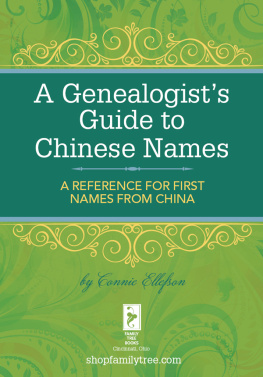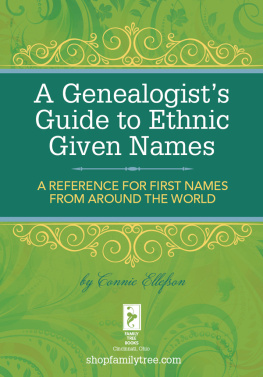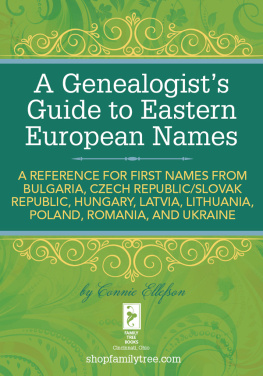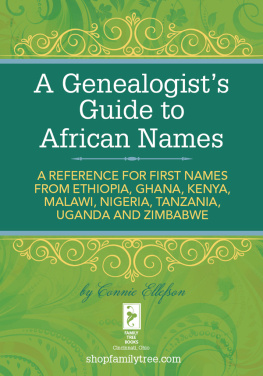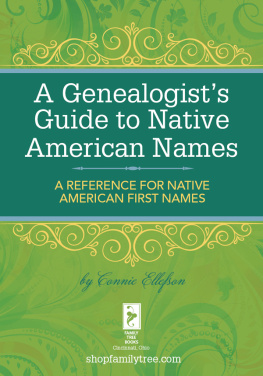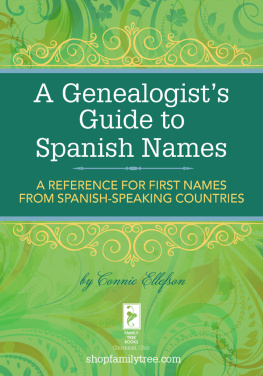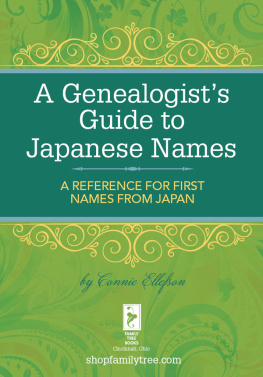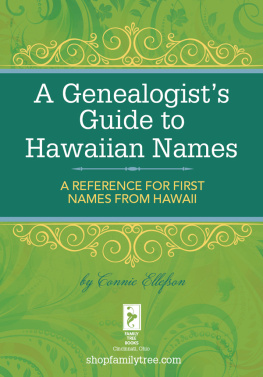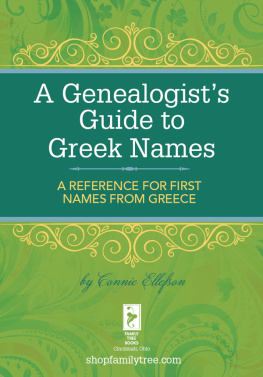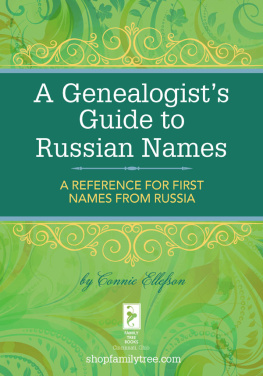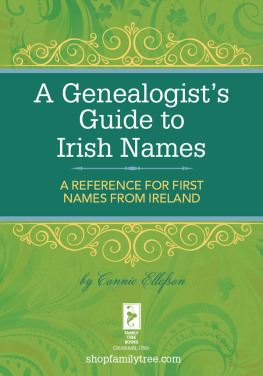A Genealogists Guide to Chinese NamesA REFERENCE FOR FIRST NAMES FROM CHINAby Connie Ellefson Cincinnati, Ohio shopfamilytree.com
China
History
Chinese people have been in the New World since the sixteenth century and possibly earlier. They were servants of Spanish sailors in 1565 and arrived in 1635 as shipbuilders in Acapulco and colonists in Mexico City. Documented cases of Chinese sailors, carpenters, smiths, students and others show their presence in the first half of the nineteenth century, but it wasnt until midcentury that they began to arrive in large numbers. Drought in the Canton province of China between 1847 and 1850 sent over 41,000 Chinese to America. Some came later to seek their fortune in the gold rush. They were among the first to stake their claims in California, but as their numbers grew, legislation was enacted to exclude them.
They then followed new gold strikes in other western states, migrating as far east as Black Hills, South Dakota, often gleaning gold from abandoned lean claims. The rise of so many Chinese laundries had its roots in the gold rush for the shrewd reason that in offering a service white men considered womens work, Chinese could make the leap between hired hand and boss. Although doing laundry in those days was hard work, it was less hazardous than digging railroad tunnels. An estimated 12,000 to 14,000 of their countrymen were put to work between 1858 and 1869, building California railroads, and later the Central Pacific Railroad, which formed the western link of the transcontinental railroad. Chinese workers made up nine out of ten workers for the railroads constructed in this part of the country. They often worked under slave-like conditions, doing the most dangerous work for low wages.
Their strike for wages equaling the Caucasian workers was unsuccessful. Completion of the railroad opened up the West for development of its other resources. An 1868 treaty with China ensured a steady supply of Chinese laborers for agricultural work. Their efforts converted the swamps of the San Joaquin Valley into rich farmland. Chinese were also employed in the cigar, shoe and garment industries and in woolen mills that developed in California. Immigration averaged more than 12,000 each year during this period, resulting in a Chinese population of 105,000 by 1880, mostly in California.
Other Chinese were hired to work in silver and coal mines throughout the West and in the canneries of the Northwest. Chinese developed shrimp and abalone fishing around San Francisco, as well as starting their own cigar, shoe and garment enterprises. Hard times in the 1870s, combined with the U.S. westward expansion arriving in California, resulted in an oversupply of Caucasian workers needing jobs held by Chinese. Public clamor to get rid of the Chinese culminated in the passage of the Chinese Exclusion Act of 1882, which prohibited immigration of Chinese laborers for ten years. The law was extended for another decade in 1892 and 1902.
A policy of almost total exclusion of Chinese continued until 1943, when wartime manpower shortages again made jobs available for them. A number of war brides and fiancees of GIs began to immigrate after 1945. From then until 1970, women outnumbered men among Chinese immigrants, whereas nineteenth century immigrants were almost exclusively men. After immigration restrictions were lifted in 1965, Chinese immigration increased dramatically as families long separated were reunited. From less than 1,000 annually in the 1950s, their numbers increased to 12,000 annually in the 1970s and 20,000 to 30,000 per year in the 1980s.
Language
Throughout the Orient, Chinese characters are mutually intelligible to literate people, regardless of dialect or language.
Each language attaches its own pronunciation to the characters and may change the meaning slightly. In contrast to English, in which the language of six hundred years ago is almost completely different from today, Chinese works written four thousand years ago can be read by modern-day Chinese.
Naming Traditions
Because of the extreme difficulty in transliterating Chinese names into English words, the Chinese name list is very small. Its meant to be a representative sampling of the kind of names that might be chosen, because in the Chinese culture, names are designed to be unique. Each child is given a carefully conceived name, and its meaning may be known only to the parents. A person may be given new names at later stages of life, such as when starting school, getting married or beginning a career.
Traditionally, Chinese took a generational name as part of their names, which was one word of a poem that did not contain repeating words. Each generation in turn would take the next word in the poem. Religious names are rare, and a girl is often given a more flowery, elegant name than a boy. Boys names may be very plain or attempt to appear that his presence is a matter of indifference in order to trick the devils into leaving the (preferred) male child alone.
Chinese Female Names
Ah Cy lovely
AhKum good as gold; Gum
AhLam like an orchid
An (AHN) peace
Bik jade
Bo (BAU) precious
Chao-
xing (chau-TSEENG) morning star
Chow summer
Chuhua (choo-KHWAH) chrysanthemum
Chun (CHWEN) spring
Chyou (CHYOH) autumn
DaChun long spring
Da-Xia (dah-SHAH) long summer
Dai-
tai leading a boy in hopes boy will follow
Eu-
fnh playful phoenix
Eu-
meh (YOO-meh) especially beautiful
Fang (FAHNG) fragrant
Far flower
Fung bird
Guan-yin (kwahn-YEEN) goddess of mercy
Howin a loyal swallow
Hu (HOO) tiger
Hua flower
Hifang (hweh-FAHNG) nice fragrance
Hwei-
ru (WHEH-roo) wise, intelligent
Jiahui (jah-HWEI) nice
Jing-
wei (tcheeng-WEH) small bird
Jun (TCHOON) truth
Kuaihua (kwigh-KHWAH) mallow blossom
Kueching (goy-CHEENG) piano reach-sounds good
Kwong broad
Lee plum
Lha (lee-WHAH) pear blossom, beautiful flower
Lian (LEE-AHN) the graceful willow
Lien (LEE-EN) lotus
Lienhua (lee-en-HWAH) lotus flower
Lihwa (lee-HWAH) a Chinese princess
Lin beautiful jade
Ling (LEENG) delicate and dainty
Lxe (lee-SHWEH-EE) beautiful snow
Marrim (MAH-reem) tribal name among Purim Kukis in
Manipur State
Mh- beautiful posture
Mh-fnh pretty or beautiful phoenix
Mei can mean beautiful, plum, sister or rose
Meiying (MEH-yeeng) beautiful flower
Meizhen (meh-CHE-UHN) beautiful pearl
Ming-
ha 
